
Class Activities
Appropriation: Memes
Background:
Arthur is a Canadian/American animated educational show directed to children. The Arthur show revolves around the life of Arthur Reed, who is eight-years-old, and his daily interactions with his friends and family.
Appropriation:
Dictionary.com states that a meme is an element of culture or system of behavior that may be considered to be passed from one individual to another by non-genetic means, especially imitation. The fascinating thing about memes is how accessible and easy it is to create. By using popular TV shows or funny pictures of people, a meme is created when a caption is added to it. Most often times the picture or scene chosen for a meme has nothing to do with its actual context.
The Arthur memes, as shown below, have nothing to do with the TV show. Scenes were taken from the show and appropriated to mean totally different things.
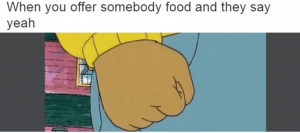
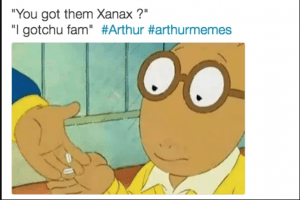
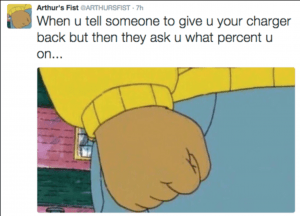
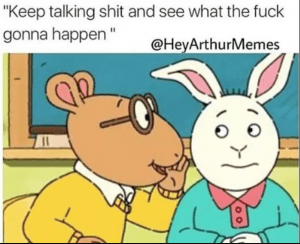
Appropriation show and tell “Vapourwave”
PDF Document
I chose the vapourwave genre not only because I like listening to it, but also because I think it is a perfect example of appropriation. It takes samples of songs from the 80’s – 90’s (typically jazz, elevator, disco, r&b, hip hop music), and transforms them into something new. Well not really new, but something very different from the original songs. The samples usually get chopped up, slowed down, filtered, or cut, which gives the new appropriated piece a very chilled out, laidback and slow vibe, thus giving perhaps nostalgic, utopic or surrealist feelings to the listeners. Vapourwave is also based around the concepts of failed promises of capitalism, hence the music and visuals are often associated with old commercials, computer softwares, technology, popular entertainment etc.
Aesthetics play a big role in the genre too. Aesthetics is a word usually associated with the visuals that go with the music. It’s what makes up vapourwave, its unique visuals. Often you’d see Japanese letterings, old Microsoft layouts, brands, purple / pink color schemes and retro style graphics in music videos of the genre. Again, taking old visuals from the 80s and 90s, and transforming them into something new. Sort of like a collage thing. Examples of music and aesthetics can be seen in the PDF document above.
With the themes of nostalgia, capitalism, consumerism, satire, surrealism, and not to mention the art, really gives this genre its uniqueness and makes it a great example of appropriation.
Appropriation: Neil Cicierega’s Mouth Sounds Trilogy
Neil Cicierga is a comedian, artist, and musician, known for his web series Harry Potter Puppet Pals, his musical works under the name Lemon Demon, and a creating a style of flash animation known as “Animutation.”
Recently, Neil has been gaining notoriety for something else; he has been producing mashup albums under his own name that consist of almost entirely appropriated sound clips. The first and second albums, titled “Mouth Sounds” and “Mouth Silence,” were both released in 2014, while the third, “Mouth Moods,” released earlier in 2017. These have been referred to as the Mouth Trilogy due to their titles and recurring use of the song “All Star” by Smash Mouth.
The albums grew out of Neil’s discovery that the Rock Band series of video games includes separate stems for every instrument in the game, allowing him to pull individual parts out of the songs. Most of the songs on the albums involve fitting the vocals of one track to the backing of another, and a good example from Mouth Sounds is “Bills Like Jean Spirit.” The track consists of the lyrics to Nirvana’s “Smells Like Teen Spirit” over the backing track for Michael Jackson’s “Billy Jean.”
Not all tracks follow this format though. “No Credit Card” only uses Huey Lewis and the News’ “The Power of Love,” while the track “D’oh” uses at least six distinct sources.
Neil has stated that Mouth Sounds was created to make people laugh, and also to offend the fans of the tracks that he used.
While Mouth Sounds has the reoccurring element of Smash Mouth’s “All Star,” it is replaced with the song “Semi-Charmed Life” by Third Eye Blind in the “prequel” album, Mouth Silence. Notable tracks that use this include the opening track “Goodbye,” and finale “Piss.” Despite this, All Star is referenced in various ways. The wispy wind sounds found throughout the album are actually samples from All Star slowed by 1600%, and the Morse code found in the album’s climactic finale “Piss” translates to “Somebody once told me.”
Mouth Silence also introduced “themed” tracks to the albums, tracks that exclusively use songs that mention a specific word. My favorite is the track “Best,” which includes samples from the Rockapella’s Folgers jingle, One Direction’s “Best Song Ever,” Tina Turner’s “The Best,” and the Pokémon theme song.
On January 23, 2017, Neil Cicierga released the most recent album in the series, “Mouth Moods,” which features much more involved mixes than the first two. The average number of sources is around 4.5 per track. This album’s recurring element is “One Week” by Barenaked Ladies, though All Star and Semi-Charmed Life make prominent appearances as well.
Notable tracks include “Wallspin” (Wonderwall and You Spin Me Round (Like a Record)), “T.I.M.E.” (Hans Zimmer’s Time from Inception with Y.M.C.A), and “Mouth Pressure” (All Star and Under Pressure).
All three albums have been met with almost universal critical praise.
http://www.neilcic.com/mouthsounds/
http://www.neilcic.com/mouthsilence/
http://www.neilcic.com/mouthmoods/
Appropriation Show and Tell: “Look What You Made Me Do”
Appropriation can be found in many music videos and remixes. A recent example of a music video that uses appropriated material is Taylor Swift’s “Look What You Made Me Do”.
Swift borrows the melody from the 1991 song called “I’m Too Sexy” by Right Said Fred. This can be heard after Swift says “ooh” in the beginning of the song and the chorus begins. Interestingly, the group did not know that Taylor Swift used their melody until after the song was released. However, she did give them credit by having them be co-songwriters on the song.
Also, many of the shots in Swift’s music video are similar to shots in other music videos by different artists. Here are some:

Michael Jackson’s “Thriller”


Katy Perry’s “This Is How We Do”


Madonna’s “What It Feels Like For a Girl”


Kylie Minogue’s “All The Lovers”

Kaws
Appropriation Show & Tell: From “It Must Be Jesus” to “Gold Digger”
Some people know that the song “Gold Digger” by Kanye West appropriates the song “I Got a Woman” by Ray Charles, using the same melody and lyrics. But what a lot of people don’t know is that “I Got a Woman” is also an appropriation, taking its melody from a song called “It Must Be Jesus” by The Southern Tones but completely changing the subject matter of the song. Through two different appropriations, “It Must Be Jesus” becomes “Gold Digger.” I think this is a prime example of how something can be appropriated and essentially repurposed to take on a completely different meaning than what was originally intended.
Show and Tell: SiIvaGunner
When it comes to appropriated content, a prime and common example most people are familiar with, are remixes and mashups. Being that they incorporate elements from two or more songs into one work, is already a form of appropriation in itself. Although, you don’t really have to stop there, as shown by youtube channel SiIvaGunner.
SiIvaGunner is a music youtube channel, making claim to the fact that their content entirely consists of “High quality rips”, as in, music ripped directly from game files. Each video posted is titled with the song name and game it’s from, each description lists the title of the song, the composer, performers, and platform of game of origin. Pretty standard, right?
It would be, were it not for the fact that none of these videos are technically “rips”.
They’re all mashups. Every single one of them.
Despite not listing or advertising any of the other melodies or songs (often sneakily) inserted into the original track, a large number of the posted tracks have an asinine number of other songs combined into the product. This alone takes a huge amount of skill, but the fact that often times the song actually sounds pretty good, is an accomplishment in and of itself.
The video, titled after the ‘main’ song featured, still uses all the same instruments from the original Hyrule Field and Ocarina of Time’s soundtrack, and should you show this to someone who’s not as familiar with the Zelda series they might notice just a melody here and there. But, the song rewards listeners with keen hearing because if you’ll read the top comment, you’ll see a list of 30 different songs that apt listeners identified as being inserted into this mashup in one way or another, if only for a very brief few notes. None of these songs were listed in the description, mind you.
It comes to a point where each of these videos, of which SiIvaGunner uploads several every day (which they are able to do since they are in fact a collection of artists, as opposed to one apparently superhuman individual) is sort of like a game or a scavenger hunt for the listeners, where they band together to identify the songs used in the mashup.
Some of them are essentially just memes, though.
In class exercise- December 2
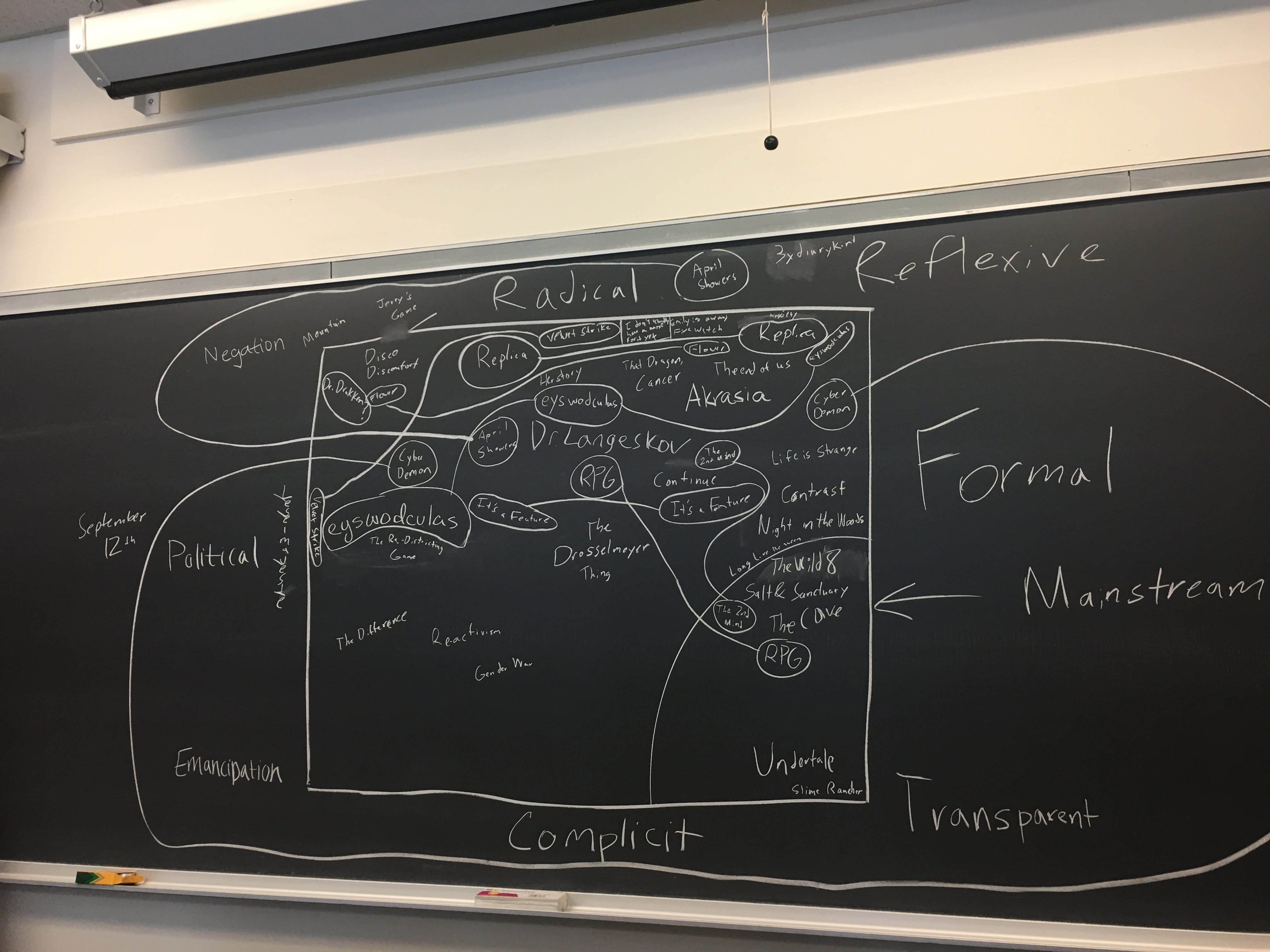
Indie Game – Salt and Sanctuary
Salt and Sanctuary
Salt and Sanctuary is a 2D action RPG by Ska Studios.

This game is basically 2D Dark Souls mixed with some Castlevania. The reasons why I love this game are similar to the reasons I love Dark Souls. The combat is crunchy, the lore is mysterious, the level design is interconnecting and interacts with everything else. The atmosphere is also dark and washed out which I like a lot.
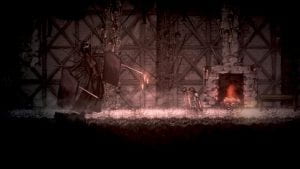
Here is the trailer…